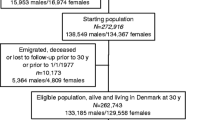Abstract
Recent research suggests that intrauterine exposures, perhaps factors that influence birth weight and other indicators of fetal growth, may affect future breast cancer risk. Because birth weight shows seasonal variation in Sweden, we assessed whether risk for breast cancer is associated with month of birth. The analyses included all 115,670 women, born between 1858 and 1968, who were reported to the Swedish Cancer Registry in 1958-89 as having breast cancer. Poisson regression models were used to examine the data. After adjustment for seasonality of number of live births in the population at risk, a significant seasonal pattern was identified for women born between 1880 and 1920. Women born in June had a 5% higher risk of breast cancer than those born in December. By contrast, there was no evidence of birth seasonality among 440,948 women with cancer at other sites. Exposures relevant to breast cancer risk later in life are unlikely to be related to month of birth. Thus, prenatal or early post-natal factors influence breast carcinogenesis, but the seasonal variation in these factors must have decreased over time.
Similar content being viewed by others
Author information
Authors and Affiliations
Rights and permissions
About this article
Cite this article
Yuen, J., Ekbom, A., Trichopoulos, D. et al. Season of birth and breast cancer risk in Sweden. Br J Cancer 70, 564–568 (1994). https://doi.org/10.1038/bjc.1994.346
Issue Date:
DOI: https://doi.org/10.1038/bjc.1994.346
- Springer Nature Limited
This article is cited by
-
Does month of birth influence colorectal cancer prognosis?
Langenbeck's Archives of Surgery (2023)
-
Seasonal variation in the month of birth in patients with skin cancer
British Journal of Cancer (2014)
-
Birth season and breast cancer risk in Japan
Breast Cancer Research and Treatment (1996)




